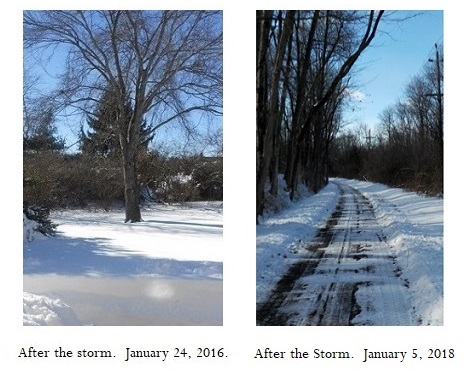|
Judy Malloy:
These ten weeks of writer's notebook selections are artist's documentation of the process of creating Arriving Simultaneously on Multiple Far-Flung Systems, a virtual reading machine. Although no words have been changed in these excerpts, divertive portions of the original notebook have been omitted. Omissions are represented by [...]. Explanations that were not in the original notebook are enclosed in brackets. Additionally, the order of the entries has been changed from the original blog format of latest-entry-first to a sequential order.
November 5-6, 2017
When a new work of electronic literature moves from the early planning/writing/coding stage to initial implementation and testing, sometimes everything works as planned. Sometimes nothing works as planned. This has been an in-between experience. Some things are working well; some things need improvement. 1. diana_begin.html. The initial top interface page is composed of active spaces that each lead to a different opening page; each reader choice sets the stage for a different part of the story; eventually they will intertwine. Some of the text that the top page calls will briefly appear on the top page itself. Other text will appear on separate pages. The initial top page is currently in the throes of serious design and image issues, but the idea is working. 2. Generated phrases and sentences. As shown on the left-hand column of the adjacent figure, a series of files has been created. Although there are only four files indicated in this preliminary chart, it works better with five files. The fifth file concerns Diana's summer job. Each module consists of an image that keys it, phrases and sentences, and code that generates the stored text at random. So far, I am happy with how the generated text is working, but there are issues with how the modules will eventually interweave. Additionally, although, my decision to write Diana's voice as notebook entries that are not writer's voice-embellished gives a certain energy to the work, this needs to be somewhat improved. The samples below generate 2-4 variables from each module. They are very preliminary because much more text needs to be entered (and there are mistakes). However, they are helpful in seeing what is working and what is not working. Note that each image-keyed file is a separate module. This will allow user image-generated searches that combine the files in various ways. It is always a thrill to see a long-planned work begin to take shape!
3. Images. The images in Arriving Simultaneously on Multiple Far-Flung Systems are planned to be flexible, by which I mean that the texts they refer to will change. For instance, the cabin image initially combines with Diana's workplace, but it will also combine with her love affair with and eventual marriage to Roland. A chart of all the images in Arriving Simultaneously (so far) needs to be created and keyed to credits to the source of each image. Although I used images as icons to key text in maps; in my card catalog The Woodpile (1979); in the early web version of the Blue Notebook (Uncle Roger File 2); as well as in A Party at Silver Beach, the use of images in my work has not been predominant since the days of making maps and "card catalog"-based narratives. Thus, I would like to also call attention to JR Carpenter's algorithmic electronic manuscripts, created with integrated images and generative text -- as well as to Deena Larsen's combinations of images and text in Marble Springs -- as being innovative examples of the use of images in conjunction with story-bearing text [..] In the case of Arriving Simultaneously, because the text is generated from different modules, ultimately, the images are important in situating the reader within fluctuating time-frames in the narrator's life. In order that they be meaning-laden but not didactic, many of the images are designed to fade unobtrusively into the background.
November 9, 2017 L ast night new variables were entered in the "early programming" array of Arriving Simultaneously on Multiple Far-Flung Systems. This morning, testing the generated results in combination with the cabin array, I am thrown back in time. It is the summer of 1968, almost exactly a year from the launch of Apollo 11.
[...]
November 20, 2017 W ith intense work on the writing, coding and interface design, the first of the three P2P dynamic manuscript pages that will comprise Arriving Simultaneously on Multiple Far-Flung Systems is working to the point that it "plays" elegantly, particularly on an iPad touch platform. However, much more writing is necessary, and before it is done, I need to read various histories of satellites and to once again confront the FORTRAN IV (FORTRAN 66) manual.
T he images above depict reader movement from the top page, to reader "on-the-fly" generation of the first manuscript of Arriving Simultaneously on Multiple Far-Flung Systems, to an accessible single array-displaying window. I look forward to generating all the arrays in a continuous printout. Meanwhile, composition observations are recorded here. 1. In Uncle Roger File 3 and its name was Penelope, I coded generative hypertext to create narratives where the meaning slowly built up in unpredictable ways. A part of the composition process was to continually replay the work until I was certain that the lexias worked together in whatever order the reader received them. Later, recollected on this early morning was composed with looping, interlocked lexias that slowly revealed submerged narrative information about the life of a woman artist. Although inspired by the recollected interface, Arriving Simultaneously is designed to reflect the life of a woman programmer. Thus, it is a dynamic manuscript, created/recreated with JavaScript in a HTML/CSS structure and read "on-the-fly". Visual icons give Arriving a playable feel, as well as contributing to reader control of the manuscript. However, like the bat(s) in Gregory Yob's Hunt the Wumpus, the punch card icon has the power to transport the reader in unpredictable ways. 2. The generative hypertext that I used in its name was penelope and The Not Yet Named Jig was influenced by my own card catalogs, as well as by the use of multiple imagery by conceptual photographers and artists, such as Jennifer Bartlett, Sol LeWitt, and Lew Thomas. Using paragraph-sized units that stand by themselves (lexias), this method of writing created a relatively coherent narrative because each lexia was written to either stand by itself or be combined with other lexias. However, beginning with Another Party in Woodside (a prize winner in the Neukom Institute for Computational Science at Dartmouth's Turing Test in the Computational Arts) and continuing with "the whole room like a picture in a dream", I created strategies for composing generative literature using sentences and phrases as variables. In my work, the goal of computer-mediated literature is not to eliminate all traces of the process. For instance, although, it can be programmed out, I retain repetition to emphasize the presence of aleatory composition. Additionally, because nonsequential sentence juxtaposition sometimes occurs in Arriving Simultaneously, I would like to point out that we do not always remember in chronological order. And, when the whole works (sometimes I rewrite if it does not work), the evidence of a random composition process is poetic and musical. 3. It is generally proper to refer to aleatory computer-mediated creative work as pseudo-random. But because pseudo-random is not understandable to general readers, I have of late eliminated the "pseudo" from the text in this notebook. The expert on pseudo-random and the elusive "true" random is, of course, Donald Knuth. (see The Art of Computer Programming, Volume 2, Chapter three: "Random Numbers").
November 25, 2017 O n Thanksgiving Day. it was a pleasure to talk with my family in California, and then I made some variations in the interface design of the first dynamic Arriving Simultaneously on Multiple Far-Flung Systems manuscript. Later, sitting in the woods (evading the FORTRAN IV manual), I went back in time to write a little more for the "route 128" array. It was a beautiful winter day, and somehow I veered into working at the Harvard Coop bookstore during Christmas vacations -- an experience I like to remember. So, I gave it to Diana. For the record, this being a notebook, a few examples of the current interface design and of the new text in the output are recorded below. The purpose of doing this is to compare the changes with what existed before. Sometimes -- this may be one of those times -- a decision to revert to the original may be made.
L ater on Thanksgiving evening, I was continually generating the manuscript on my tablet -- looking for mistakes and getting a feel for how the arrays work together, when I began to feel as if Diana was talking to me -- an eerie experience that I have never before had as a writer. It would be more common to merge with the personality of the character. As is my usual practice, and because I need to test how it runs on a tablet, the in-progress first manuscript page of Arriving Simultaneously on Multiple Far-Flung Systems is now online at https://people.well.com/user/jmalloy/arriving/diana_icon_interface.html This is not the top page because the top page won't be finished until all the manuscripts it accesses are completed. To both give the reader more details and avoid too much repetition, each array should contain about 40 variables. There are 6 arrays, each now containing about 10-20 variables, so there is much more writing to do. Reader, remember, if you visit this work in progress, that each icon randomly generates a different array, and that since I will be adding new writing as often as possible, the work will be in flux -- at least until January when I begin to work on the second Arriving Simultaneously on Multiple Far-Flung Systems manuscript. The second manuscript will take place in Silicon Valley.
December 10-11, 2017 A rriving Simultaneously on Multiple Far-Flung Systems is a generative electronic manuscript. The first "page" in this work -- the page I am working on now -- is composed with six arrays and a few associated unconventionally-nested arrays. As I, the writer, mine my memories to convey the experience of the computerization of a Colorado aerospace technical library in the late 1960's, the reader of this work experiences the spare, compressed memories that would be expected from a narrator, who is looking at her life many years later. We don't remember sequentially. I repeat. We use the affordances of electronic literature to tell stories differently. As with any form of writing, the whole takes a while to come together. At night running and rerunning Arriving Simultaneously on my tablet allows an understanding of the flow of a work in which increasingly, no one reader will ever see the same screen. At night, reading narratives of earlier eras when women programmers were expected and welcomed, the stories of women coding -- not only during World War II but also in the 1950's and 1960's --emerge. Earlier this fall, reading Margot Lee Shetterly Hidden Figures - The American Dream and the Untold Story of the Black Women Mathematicians Who Helped Win the Space Race, I was immersed in the extraordinary lives of Katherine Johnson, Dorothy Vaughan, Mary Jackson, and Christine Darden and many others. In October, immersed in Julianne Nyhan and Andrew Flinn's Computation and the Humanities: Towards an Oral History of Digital Humanities, I explored the role of early computing in the history of the digital humanities. In November, Nathalia Holt's Rise of the Rocket Girls: The Women Who Propelled Us, from Missiles to the Moon to Mars stared at me from a library shelf. Initially, turned off by the 50's hairstyles and culture, I checked out the Wonder Woman DVD instead. A week later I returned and checked out Rise of the Rocket Girls. Soon, I was deep into the work of the women mathematician/computer programers at JPL. Helen Ling, Barbara Paulson, Susan Finley, Sylvia Lundy Miller, and many others. By the time I had finished, from a media archeology point of view, I felt as if the culture of the 1950's -- and how these women emerged from that culture -- was important in the narrative -- just as the maverick culture of Boulder Colorado is important in Todd Neff's From Jars to the Stars. And yes, Neff does describe what the men did in their spare time and even sometimes what they wore. F or Arriving Simultaneously, I could have created a woman mathematician. That was my original intention, but the details of the life of a mathematician were not in my memory. Instead, Diana is a music major [I was not a music major, but I played the violin and was familiar with this territory], an early information retrieval programmer for a NASA contractor (at a time when information retrieval systems were not well developed and documented), a Silicon Valley-based database designer, and eventually a core figure in computer-mediated community networking. It was at Leopold Records in Berkeley, when Community Memory was installed there in 1973, that Diana first encountered community networking. And at its core, Arriving Simultaneously is an Internet story, that celebrates in spirit all the men and women who built the non-profit communities of the Internet. However, with Electromagnetic Research Corporation running fictionalized in the background [avoiding for consistency, the complexities of real life, I moved ERC from College Park, MD to route 128 outside of Boston], the story begins in a NASA contractor's technical library in the late 1960's.
As was the norm in that era, I left Ball Brothers Research Corporation (BBRC, now Ball Aerospace) in the summer of 1970 when my then husband went to work as head of a new Fairchild division. But for years I remained awed by the grandeur of the Orbiting Solar Observatory. Thus, the time I spent as project head for computerizing the BBRC library was an experience that was important in its right. In my life, it also fueled a lifetime investigation of computer-mediated literature -- as well as years of work in artist-centered community networking. Additionally, it engendered concerns about what artists could not undertake with the resources available. In response, in 1981 I created Technical Information, an installation in which small works of information art (such as my card catalog series) were housed in a satellite-reminiscent structure that was surrounded by [...] literature of science and technology, arrayed on shelves that I built on the wall that encircled the art. The inviting editor for my Leonardo paper that describes this project was Roger Malina, whose father, Frank Malina, was one of the founders of JPL. M y copy of Todd Neff's detailed and fascinating From Jars to the Stars: How Ball came to build a comet-hunting machine has arrived [in November], and as Arriving Simultaneously progresses, I am reading this book.
December 26, 2017
"The way the search results appeared line by line... I t is always interesting to see how additions to databases change the search output. But it was particularly magical in the late 1960's when the process of creating a database was still a mystery, commercial database applications were not (to my knowledge) available at all, and databases were generally created from scratch with Fortran, punch cards, a large computer, and continuous feed paper output. As I wrote the words that lead off this entry, something I should have realized long ago was apparent: it is not only the coding but also the process of adding new data, running the program, and adding new data that are the heart of much of my work. All of these things were influenced by my work at Ball Aerospace. Thus, in surprising ways, corporate environments have incubated electronic literature. I am thinking also of James Tenney's residency at Bell labs from 1961-1964 and his role in fostering Fluxus generative Poetry and of Bolt Beranek and Newman (BBN) programmer Will Crowther, who developed Adventure in Fortran on BBN's PDP-10 in the 1970's. In addition to the joys of the holidays, the past few days have been spent reviewing the progress of Arriving Simultaneously on Multiple Far-Flung Systems. As a result of playing the work over and over again, multiple small edits and the following observations and additions occurred.
1. As Dorothy Abrona McCrae observes in my when the foreground and the background merged (2008), 2. I'm currently working on when the punch cards were placed in the punch card reader, the name of the first file of Arriving Simultaneously. An in progress title page for the entire work now puts this initial file in the context of the whole work.
3.
January 6, 2018
[...]When the kaleidoscope icon appears and is selected, the reader moves to an environment with fewer rogue punch cards. Instead, various playable iterations of the manuscript appear. [...]I admit to remembered sadness when this icon and text were put in place. It is clear that Diana will soon be leaving the mountains. R egarding, the difference between Jenny's experience of [chip industry] tech industry culture in Uncle Roger and Diana's experience of tech industry culture in Arriving Simultaneously on Multiple Far-Flung Systems, I would like to emphasize that both Ball Aerospace and Xerox PARC were important, productive, and harassment-free experiences. Working for an aerospace company at the height of the space race was an unforgettable view of space technology. Furthermore, Ball gave teams and individuals the access and power to develop needed systems on their own initiative and in this way encouraged invention and innovation. Twenty years later, at a different time of my life, Xerox PARC was the most hospitable environment I have ever experienced as regards not only my own work, but also the experience of an office in PARC's legendary Computer Science Lab (CSL) with access to an unparalleled array of research and development -- and later the opportunity to work with distinguished hypertext programmer, Cathy Marshall. It is important that young woman, who want to become software engineers, are aware that in the real world, there are welcoming environments. [...]The story relevant to today's notebook entry is the emergence of histories of women and engineers/software engineers in space exploration. As the Mercury 13 woman astronauts found out in the 1960's, there were glass ceilings. Nevertheless, the work of the black women mathematicians/computer programmers at Langley -- and the work of the women mathematicians and computer programmers at JPL, including Chinese American Helen Ling and African American Janez Lawson -- was extraordinary. Arriving Simultaneously draws on my own much earlier experience in working with information technology at Ball Aerospace (then BBRC) in the late 1960's. But it is a pleasure to note that 25 years later the number of women at Ball Aerospace and JPL who worked in core positions on the Deep Impact Mission (launched in 2005) is inspirational. They included Systems Engineering Lead Amy Walsh, a 2006 Women In Aerospace Award Winner for her work on Deep Impact (Ball); Senior Engineer, Lorna Hess-Frey, Flyby Structures & Mechanisms Lead, Deep Impact (Ball); Michelle Goldman, Project Engineer in Systems Testing, Deep Impact (Ball); and Jennifer Rocca, Launch Activity Lead, Deep Impact (JPL). Astronomer Karen J. Meech at the University of Hawaii was the Coordinator of Earth-Based Observations. Other women who worked on Deep Impact were Systems Design Engineer Sheryl Atterberg (Ball); Software Stress Tester Kavita Kaur (JPL); and Leticia Montanez, Testbed Manager, Deep Impact (JPL). Much of this history (of course also focusing on the work of the male engineers), is well documented in Todd Neff's From Jars to the Stars: How Ball came to build a comet-hunting machine. (Denver, CO: Earthview Media, 2010) Because of its detailed documentation of the development of an amazing array of systems, this book is of value to anyone interested in innovation --- including new media artists. C ontingently, I am thrilled to see that this Spring, the University of Illinois Press will be releasing New Media Futures The Rise of Women in the Digital Arts, edited by Donna Cox, Ellen Sandor, and Janine Fron; Forewords by Lisa Wainwright, Anne Balsamo, and Judy Malloy. As I noted in my foreword to this book: "Presenting individual histories as situated in the development of the technologies themselves, New Media Futures not only provides multiple models for women interested in exploring the computer-mediated creative arts but also documents the challenges of creating digital art from the late seventies to the early nineties. Application software, for instance, was unlikely at the time when many of the artists in this book began working. Explanatory books were scarce; programs were created from scratch, often taking the form of a stack of punch cards. As Lucy Petrovic, whose work focuses on human-computer interactivity and virtual reality environments, observes in this book: 'We were writing code, step-by-step. Initially that was the only way to create art on the computer.' " |

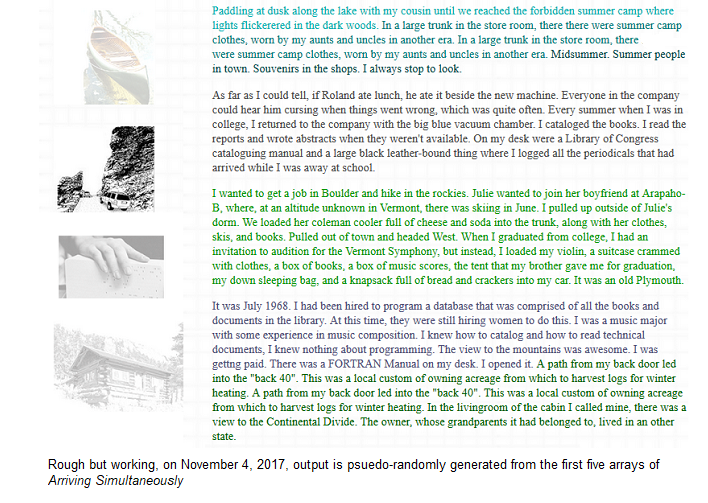
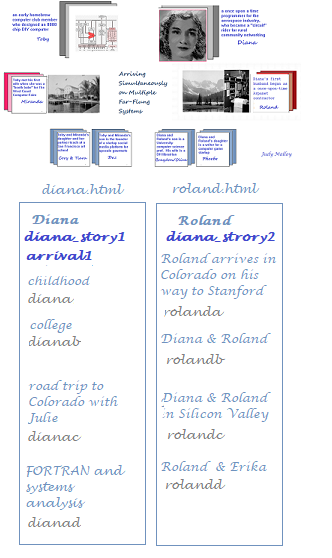 T
hese past four days, I have been immersed in the difficult job of integrating the interface, the preliminary program, and the preliminary writing for Arriving Simultaneously on Multiple Far-Flung Systems. To begin with, I'm concentrating on Diana's early life and her meeting with Roland.
T
hese past four days, I have been immersed in the difficult job of integrating the interface, the preliminary program, and the preliminary writing for Arriving Simultaneously on Multiple Far-Flung Systems. To begin with, I'm concentrating on Diana's early life and her meeting with Roland.





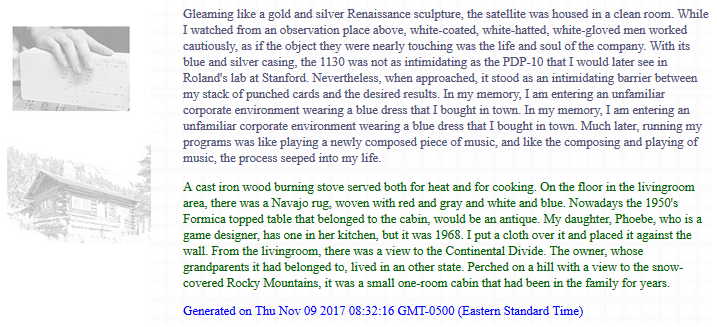
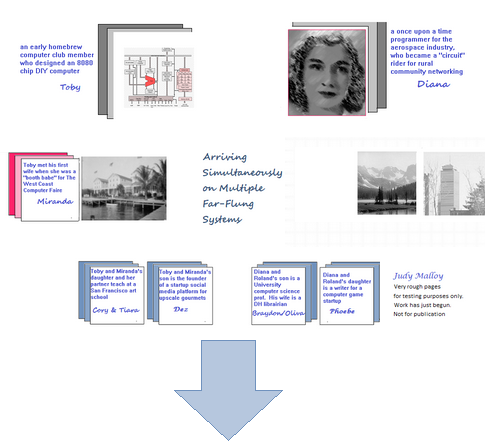
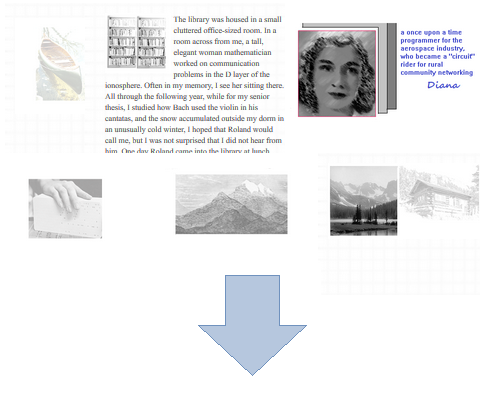
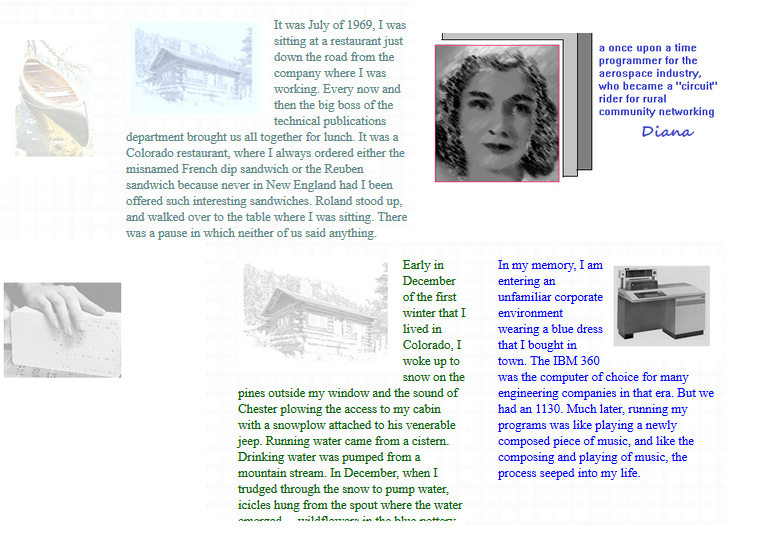
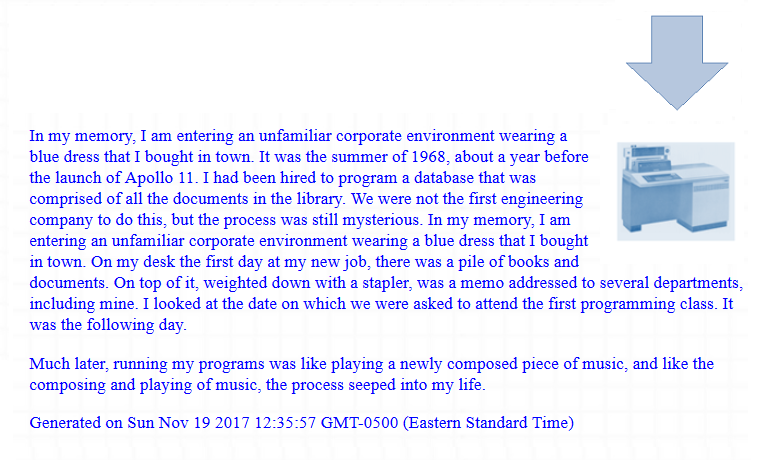
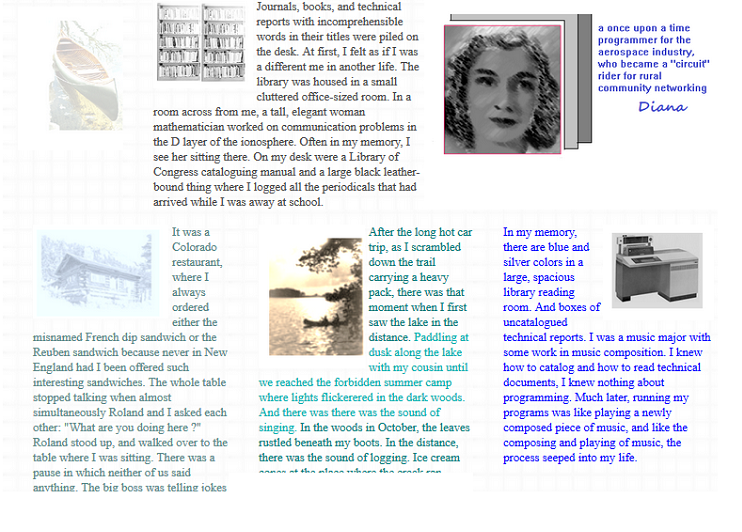
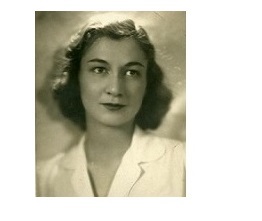 4. The image of Diana in Arriving Simultaneously on Multiple Far-Flung Systems is taken from an early photograph of my Mother, Barbara Lillard Powers, 1916-2001, Editor of the Somerville Journal, Managing Editor of the Somerville Journal; the Cambridge Chronicle; and the Watertown Press, and long ago chauffeur for the French composer Nadia Boulanger.
4. The image of Diana in Arriving Simultaneously on Multiple Far-Flung Systems is taken from an early photograph of my Mother, Barbara Lillard Powers, 1916-2001, Editor of the Somerville Journal, Managing Editor of the Somerville Journal; the Cambridge Chronicle; and the Watertown Press, and long ago chauffeur for the French composer Nadia Boulanger.
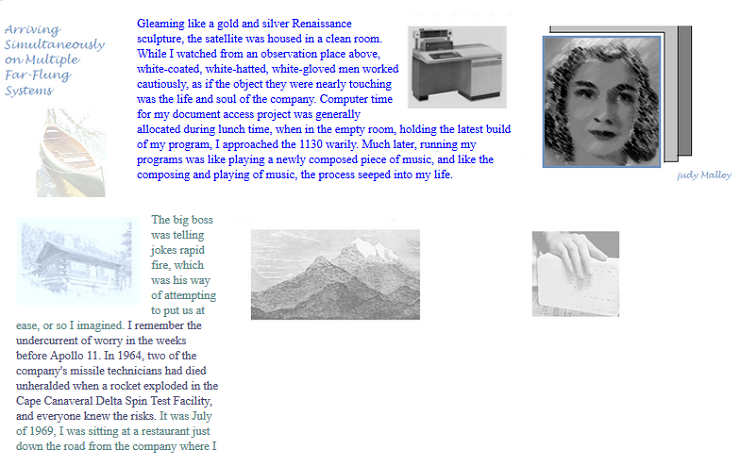
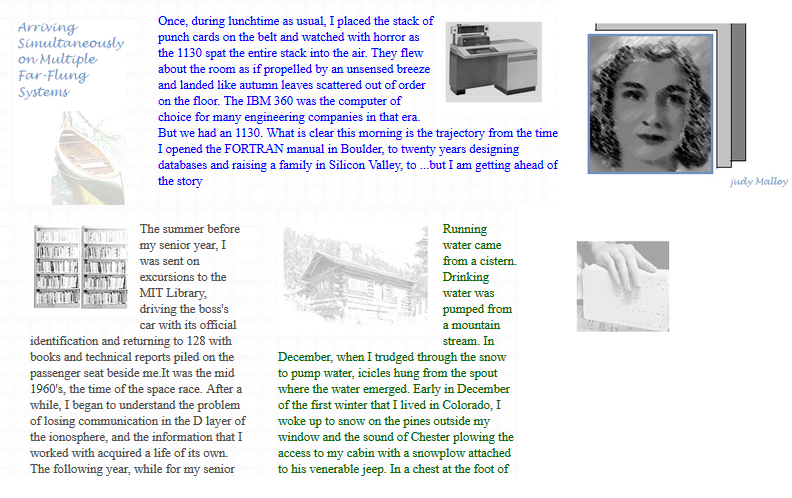
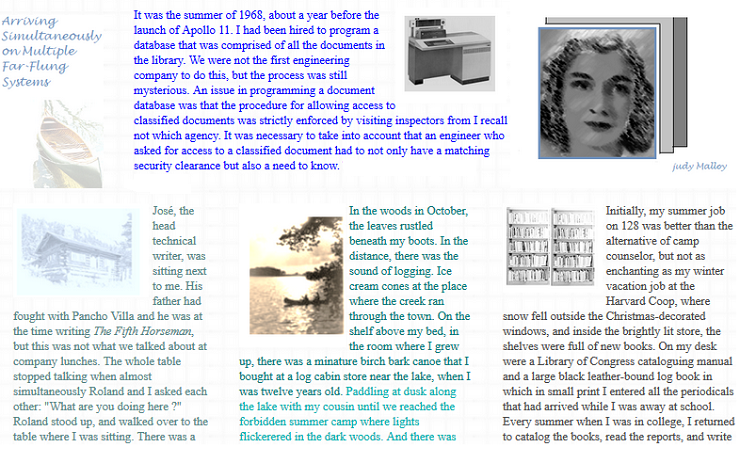
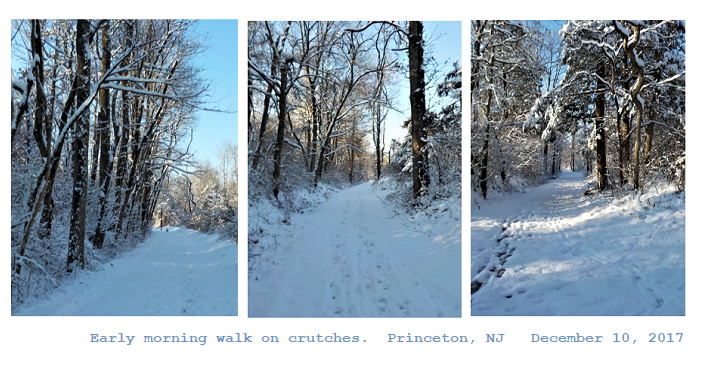
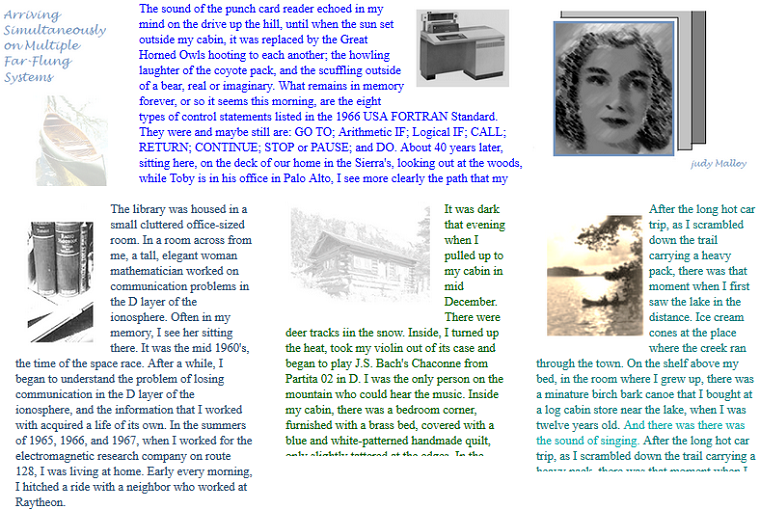
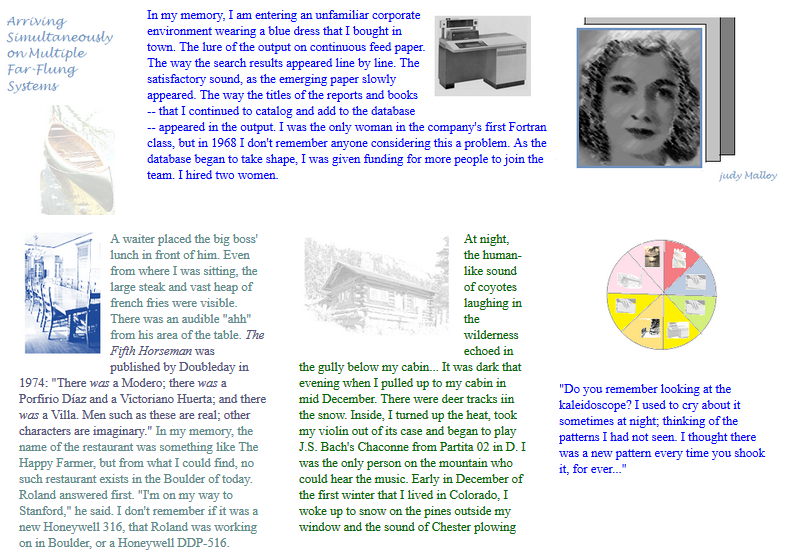
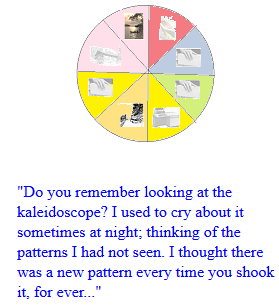 Due to the unpredictable action of the punch card function, it is not always easy for the reader to see multiple arrays at once. To provide this access, a kaleidoscope icon has now been added to the variables in the punch card function. Distinguished with Dorothy Richardson's words from Interim, the kaleidoscope gives access to a manuscript page that simultaneously displays visible text from four arrays; each time this page is accessed, the content will be different. Certain icons, such as the vehicle ascending a mountain pass, return the reader to the top page of when the punch cards were placed in the punch card reader.
Due to the unpredictable action of the punch card function, it is not always easy for the reader to see multiple arrays at once. To provide this access, a kaleidoscope icon has now been added to the variables in the punch card function. Distinguished with Dorothy Richardson's words from Interim, the kaleidoscope gives access to a manuscript page that simultaneously displays visible text from four arrays; each time this page is accessed, the content will be different. Certain icons, such as the vehicle ascending a mountain pass, return the reader to the top page of when the punch cards were placed in the punch card reader.
